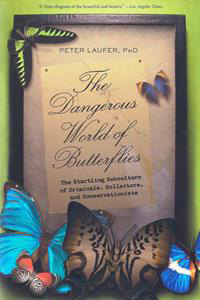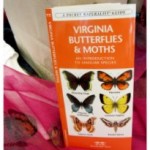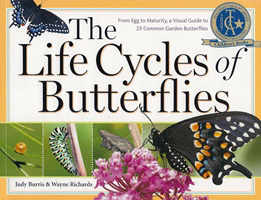"Flowers of the Air" — Reading About Butterflies
by Janet Woody, Librarian, Lewis Ginter Botanical Garden
It’s the time of year when our thoughts turn to butterflies here at Lewis Ginter Botanical Garden. Our Conservatory exhibit Butterflies LIVE! is underway until October 13. The Lora M. Robins Library (yes, the Garden has a library!) offers a wide selection of butterfly books and DVDs in addition to our collection of horticulture, botany, botanical art, and gardening books. All visitors to the Garden can use the library, but only Members can check out books. And that’s another good reason to become a Garden Member. Plus you can visit the butterfly exhibit as often as you’d like once you become a Member.
My favorite butterfly book is The Life Cycles of Butterflies by Judy Burris and Wayne Richards. This visual guide shows 23 common garden butterflies from egg to maturity. Using simple language and detailed photographs, the authors show the progression from egg to caterpillar to chrysalis to beautiful butterfly. It’s hard to imagine that something as delicate as the butterfly goes through such hardship to reach maturity. I’m especially amazed by the transition from caterpillar to chrysalis. The caterpillar has to move from its feeding location to safe, hidden location and attach itself to a support using silk created in its spinneret. Once it is securely attached, the caterpillar sheds its skin to reveal a chrysalis. Field notes are included for each butterfly showing its native range, preferred plant foods, and life cycle season. This book is filled with wonderful details and illustrations and I learn something new every time I look at it.
The Life Cycles of Butterflies by Judy Burris and Wayne Richards. Storey Publishing, 2006. ISBN: 978-1-58017-617-0. Available for purchase at our Garden Shop.
Another favorite is Butterfly Gardening: Creating Summer Magic in Your Garden by the Xerces Society and the Smithsonian Institution. In the introduction, entomologist E. O. Wilson calls butterflies the “flowers of the air”. Isn’t that a lovely image? This collection of essays will help you learn about the plant preferences of various species of butterfly and the joys of gardening for wildlife. The butterfly life cycle is explained and there are garden plans and preferred plant lists. Tips on butterfly watching and photography will inspire you to explore the world of butterflies, either in your own garden, or out in the wild, or at Lewis Ginter Botanical Garden.
Butterfly Gardening: Creating Summer Magic in Your Garden by The Xerces Society and The Smithsonian Institution. Sierra Club Books, 1998. ISBN: 0-87156-975-2
 For something completely different try Peter Laufer’s The Dangerous World of Butterflies: the startling subculture of criminals, collectors, and conservationists. Laufer is a well-established journalist who has written about topics such as Iraq and the Mexican-American border. Laufer went in a new direction for this book, thinking the world of butterflies would be gentle and bucolic. He reveals the underside of the butterfly industry where there is danger and deception. You’d never think that butterflies are involved in the world of organized crime, ecological devastation and species depletion. Read and learn about these important issues and become a better steward of the earth and its precious resources.
For something completely different try Peter Laufer’s The Dangerous World of Butterflies: the startling subculture of criminals, collectors, and conservationists. Laufer is a well-established journalist who has written about topics such as Iraq and the Mexican-American border. Laufer went in a new direction for this book, thinking the world of butterflies would be gentle and bucolic. He reveals the underside of the butterfly industry where there is danger and deception. You’d never think that butterflies are involved in the world of organized crime, ecological devastation and species depletion. Read and learn about these important issues and become a better steward of the earth and its precious resources.
The Dangerous World of Butterflies: the startling subculture of criminals, collectors, and conservationists by Peter Laufer. Lyons Press, 2010. ISBN: 978-159921-927-1
And, for your basic butterfly reference needs, you can’t go wrong with David Carter’s Butterflies and Moths, part of the Dorling-Kindersley Eyewitness Handbook series. I enjoy just paging through this delightful encyclopedia of all-the-world’s butterflies. Every page brings a new delight, and each butterfly is fully described with full botanical name, a range map, and identifying characteristics. Early stages of the life cycle are also described so you can be on the lookout for caterpillars. Introductory chapters cover generalities about life cycle, conservation efforts, survival techniques, and how to distinguish a moth from a butterfly.
Butterflies and Moths by David Carter. Dorling Kindersley, 1992. ISBN: 1-56458-062-8
If you want to focus on Virginia butterflies, and don’t want to carry a heavy book while hiking or exploring, we have just the thing for you in our Garden Shop: a folded, laminated brochure called Virginia Butterflies and Moths; an introduction to familiar species, a Waterford Press publication in their Pocket Naturalist Guide series. It has color illustrations of adults as well as caterpillars and pupae for each type. In addition to photos, there is a list of how moths and butterflies differ and how to attract butterflies. A very handy resource to take along with you on your next butterfly walk. 
Virginia Butterflies & Moths: an introduction to familiar species. Waterford Press, 2008. ISBN: 978-1-58355-419-7. Available in the Garden Shop, $5.95.
The Lora M. Robins Library is located in the Education Building; our hours are 10 am to 4 pm, Monday through Friday and 1 pm to 4 pm on Saturday and Sunday. Contact the library at [email protected].
